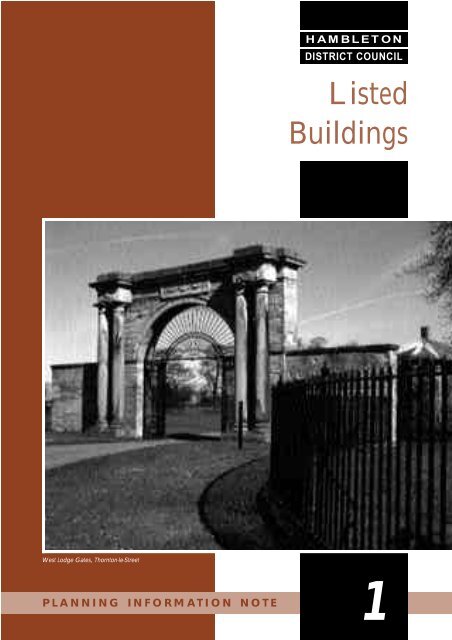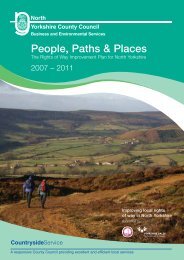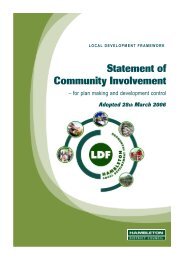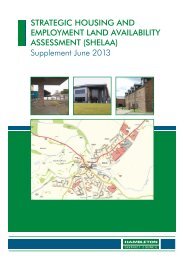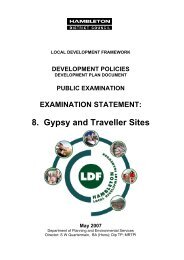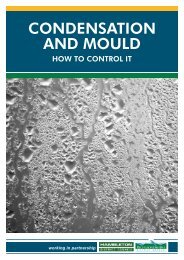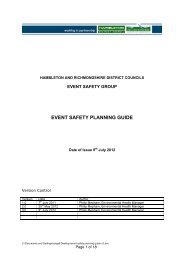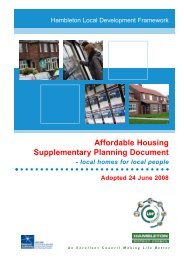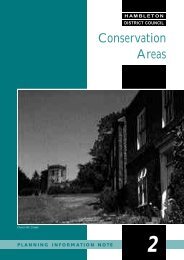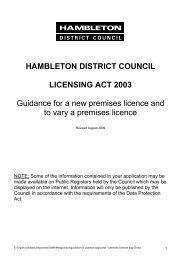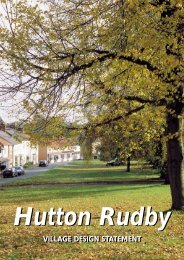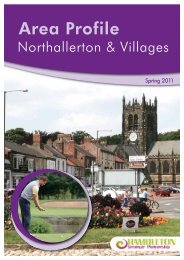Listed Buildings - Hambleton District Council
Listed Buildings - Hambleton District Council
Listed Buildings - Hambleton District Council
- No tags were found...
You also want an ePaper? Increase the reach of your titles
YUMPU automatically turns print PDFs into web optimized ePapers that Google loves.
H A M B L E T O NDISTRICT COUNCIL<strong>Listed</strong><strong>Buildings</strong>West Lodge Gates, Thornton-le-StreetP L A N N I N G I N F O R M AT I O N N O T E1
Why keep a list?We need to be able to identify our best buildings inorder to conserve and appreciate them. The<strong>Council</strong> has extra powers to protect such buildings,while owners have special responsibilities to lookafter them.How are buildings listed?The list is not compiled by the <strong>Council</strong>, but by theDepartment of National Heritage, to a set ofnational criteria approved by English Heritage.The main criteria are:-architectural interest: the list is meant toinclude all buildings which are of importance to thenation for the interest of their architectural design,decoration and craftsmanship.Brandsby ChurchIntroductionThe aim of this leaflet is to explain to ownersand occupiers of listed buildings what listingmeans and how it affects them.The list of buildings of special architectural orhistoric interest is a register recording the bestof our heritage. It contains a wide range ofstructures, not all of which are beautiful, butall of which are of special interest.There are just over 2,000 listed buildings in the<strong>District</strong>, including country houses such as BedaleHall, churches, farmhouses, farmbuildings suchas The Stables at Thirsk Hall, and industrialbuildings like the foundry at Leeming Bar.The list also includes many smaller structures,such as the Victorian urinal at Great Ayton,several telephone boxes and features suchas gates and garden walls.It also includes important examples of particulartypes of building, and building techniques such asthe use of cast iron, or the early use of concrete.Many traditional buildings which are listed werebuilt to particular plan types which are only foundin certain areas. These provide evidence for thedevelopment of regional building styles;historic interest: this includes buildings whichillustrate important aspects of the nation’s social,economic, cultural or military history, such asindustrial buildings, railway stations, schools,hospitals, theatres, town halls, almshouses,mills, etc.;close historical association: with nationallyimportant people or events;group value: especially where buildings forman important architectural or historic group orcomprise a fine example of planning such assquares, terraces or model villages.Very broadly, the following types of buildingsare listed:● All buildings built before 1700 which survive inanything like their original condition.● Most buildings built between 1700 and 1840,though selection is necessary.P L A N N I N G I N F O R M AT I O N N O T E1
● Between 1840 and 1 9 14 only buildings ofdefinite quality and character are listed; theselection is designed to include the principalworks of principal architects.● After 1 9 14, only selected buildings are normallylisted. <strong>Buildings</strong> of between 10 and 30 years oldare listed only if they are of outstanding qualityand under threat.<strong>Listed</strong> buildings are classified in grades to showtheir relative importance, as follows:● Grade I - which includes about 2% of all listedbuildings. These are of exceptional interest.● Grade II* - which includes about 4% of alllisted buildings. These are particularly importantbuildings of more than special interest.● Grade II - which includes the remaining 94% ofbuildings of special interest, which warrant everyeffort to preserve them.In <strong>Hambleton</strong> <strong>District</strong>:43 buildings are Grade I81 buildings are Grade II*1886 buildings are Grade II1 – 7 Market Place, BedaleCan the list be amended?<strong>Buildings</strong> are added to the list in two main ways:● As a result of systematic resurvey or review ofparticular areas or building types; or● Following proposals from local authorities,amenity societies or other bodies or individualsthat particular buildings should be added to thelist (‘spot listing’).Spot listing is usually used for those buildings whichwere overlooked during the resurvey in the late1980s.Examples in <strong>Hambleton</strong> include the Icehouse atBedale Hall and Winns Cottage at Sandhuttonwhere the medieval timber frame was hidden bylater brickwork.John H Gill Foundry, Leeming Bar<strong>Buildings</strong> can be removed from the list if they nolonger possess any special architectural or historicinterest, or if they are demolished. In <strong>Hambleton</strong>,there have been only 9 deletions since 1985, sothis is a rarely used procedure.P L A N N I N G I N F O R M AT I O N N O T E1
How far does the listingextend?The whole of the building is protected, theinterior as well as the exterior. There is no suchthing as just a listed facade or interior.Some parts of a listed building may be moreimportant than others. This could be significant ifyou are thinking of applying for listed buildingconsent for partial demolition or alteration.The description in the list is intended merely toidentify the building. It does not provide a recordof all the features of importance.Anything fixed to a listed building is also listed.Any structure in the grounds which was therebefore 1948 (even if not fixed to the building) islisted. This includes boundary and garden wallsand gates.The setting of a listed building is often an importantfactor when new development or extensions arebeing considered.Aiskew MillWhat are the implicationsof listing?A listed building may not be demolished,extended or altered, internally or externally, inany way that affects its character without listedbuilding consent. This is in addition to anyplanning permission required.<strong>Listed</strong> building consent may be required for thepainting of the exterior if this would affect itscharacter, and for minor works of alteration. Thusaltering the design of a window, or replacing itwith one in a different material such as UPVC, thereplacement of roofing materials or the demolitionof an outhouse would, in each case, require listedbuilding consent.The fact that a building is listed does notnecessarily mean that it must be unaltered for alltime. There is, however, a presumption in favour ofpreserving all listed buildings. The Secretary ofState has advised local authorities to give consentfor the partial or total demolition of a listedbuilding only in exceptional circumstances and, if itis necessary, only after every possible effort hasbeen made to continue the present use or find anew use for the building. Proposals for the changeof use of listed buildings must not reduce thearchitectural or historic value of the building.Myton HallIt is a criminal offence to demolish, alter orextend a listed building without first obtaininglisted building consent. The penalties for this canbe a large fine or even imprisonment.P L A N N I N G I N F O R M AT I O N N O T E1
How do I apply for <strong>Listed</strong>Building Consent?If you need listed building consent you apply onspecial forms available from <strong>Hambleton</strong> <strong>District</strong><strong>Council</strong>’s Planning and Technical Department. Insome cases, you may need both listed buildingconsent and planning permission. The <strong>Council</strong>’sprofessional staff will be pleased to advise youon this.<strong>Listed</strong> building consent will be granted only if the<strong>Council</strong> is satisfied that the proposals will not bedetrimental to the architectural or historicintegrity and detailing of the exterior or interiorof the building. Wherever possible, existingoriginal detailing and features of the buildingshould be preserved, repaired, or if missing,replaced. The aim should be to retain as much ofthe original building structure as possible.All works, whether repairs or alterations, should becarried out in a correct manner, in accordance withthe period, style and detailing of the building.Works to listed buildings require a very highstandard of craftsmanship and professional skill.In view of this, the appointment of a suitablyqualified architect is desirable.<strong>Listed</strong> buildings can become structurally weak ifdisturbed by major works.The <strong>Council</strong> must be given enough information sothat it can decide whether the work can be carriedout without danger to the building or to adjoininghistoric properties.Where necessary, the <strong>Council</strong> can imposeconditions on planning permissions or listedbuilding consents in order to control any aspectof work to a listed building.Oak House, HelperbyP L A N N I N G I N F O R M AT I O N N O T E1
Under this scheme, grants may be made availabletowards the repair of listed buildings or otherbuildings of historic interest. A leaflet giving detailsof the grant scheme is available from the Planningand Technical Department.In the town centres of Bedale, Thirsk and Stokesley,grants of 40% are available towards buildingrepair under the Town Scheme or ConservationArea Partnership Scheme. Leaflets giving details ofthese schemes are available from the Planning andTechnical Department.North Yorkshire County <strong>Council</strong> may be able tooffer grant aid towards the repair of listedbuildings. For details contact the CountyConservation Officer, telephone (0 1609) 780780.102 High Street, NorthallertonWhat are the duties ofowners?All owners of listed buildings have aresponsibility to look after them and carry outrepairs when needed. If a listed building isallowed to become dilapidated, the <strong>Council</strong> canserve a Repairs Notice on the owner.The North York Moors National Park offers grantaid towards the repair of listed buildings in theNational Park. For details, contact the Historic<strong>Buildings</strong> Officer, telephone 0 1439 770657Although the <strong>Council</strong> has powers to carry outemergency repairs and recover the costs from theowner, or as a last resort, to compulsorily purchasethe property, such measures are rarely necessary asmost owners keep their property in good repair.The <strong>Council</strong>’s professional staff will be pleased todiscuss any problems that you have concerning therepair of your listed building.42 High Street, StokesleyAre grants available?English Heritage may offer grants towards therepair of outstanding listed buildings, usually ofGrade I or II* status. Most listed buildings areGrade II and qualify only for discretionary grantaid from <strong>Hambleton</strong> <strong>District</strong> <strong>Council</strong> under itsHistoric <strong>Buildings</strong> Fund.Further advice on listed buildingsand grant aid for their repair canbe obtained from:<strong>Hambleton</strong> <strong>District</strong> <strong>Council</strong>,Planning and Technical Department,Stone Cross, Northallerton DL6 2UUTelephone (0 1609) 779977P L A N N I N G I N F O R M AT I O N N O T E1


